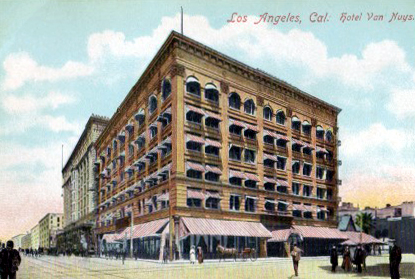June 13, 1927

Today, Los Angeles’s Main Street extends over 20 miles from Lincoln Heights to Wilmington. But in 1927, Main Street almost wasn’t.
A group of the city’s business interests, bonded together under the name of the Central Improvement Association, petitioned the City Council to change the name of Main Street to Huntington Blvd., in honor of the recently deceased Henry E. Huntington. But they had other reasons as well.
The name change would have created a continuous thoroughfare from Pasadena to the Los Angeles Harbor. It would be good for business. It would be good for property values. Plus, Main Street evoked images of a one-horse town; it was a name that belonged to a pueblo, not a thriving, young metropolis. Even the Times reporter covering the story (who was almost certainly reincarnated as a writer for Gilmore Girls) summed up the proposal as a desire to change the street name "to something less Sinclair Lewisy."
So, who comes out of the woodwork to defend the name of Main Street? Preservationists, that’s who.
Among them, Joseph Mesmer of the Los Angeles County Pioneer Society complained to the Council that too many historic city street names were in danger of being discarded. Florence Dodson Schoneman, a member of the Sepulveda family and chairman of History and Landmarks Committee for the Native Daughters of the Golden West, suggested that the city revert Main Street to its original name,
Calle Principal.
In the end, however, it was bureacracy that saved Main Street. The City Engineering Department informed the Council that a name change would significantly delay road-widening projects, since "Main Street" was designated as the area to be improved on all the relevant ordinances, notices, and triplicate forms. These would all have to be changed, to say nothing of the cost involved with changing maps and street signs.
The proposal died a quiet, bureaucratic death, but rumors persisted that the City Council had actually passed the measure and suspended it until the roadwork was completed. J.A. Graves, president of the Farmers’ and Merchants’ National Bank, collected over 1500 names in a petition to repeal the non-existent ordinance, including many notable citizens.
With his signature, Reverend John J. Cantwell, bishop of Los Angeles and San Diego, wrote, "The tendency of the present day to change street names as a means of paying tribute to the memory of some distinguished citizen tends to mar the historic connection between the old and the new."
Graves’s petition ended with these rousing words: "Leave us something of the flavor of the original pueblo for all the years to come… With the cry, ‘Vive Calle Principal‘ on our lips, we submit this petition to you, hoping that you will give it your earnest consideration."



 October 3, 1907
October 3, 1907